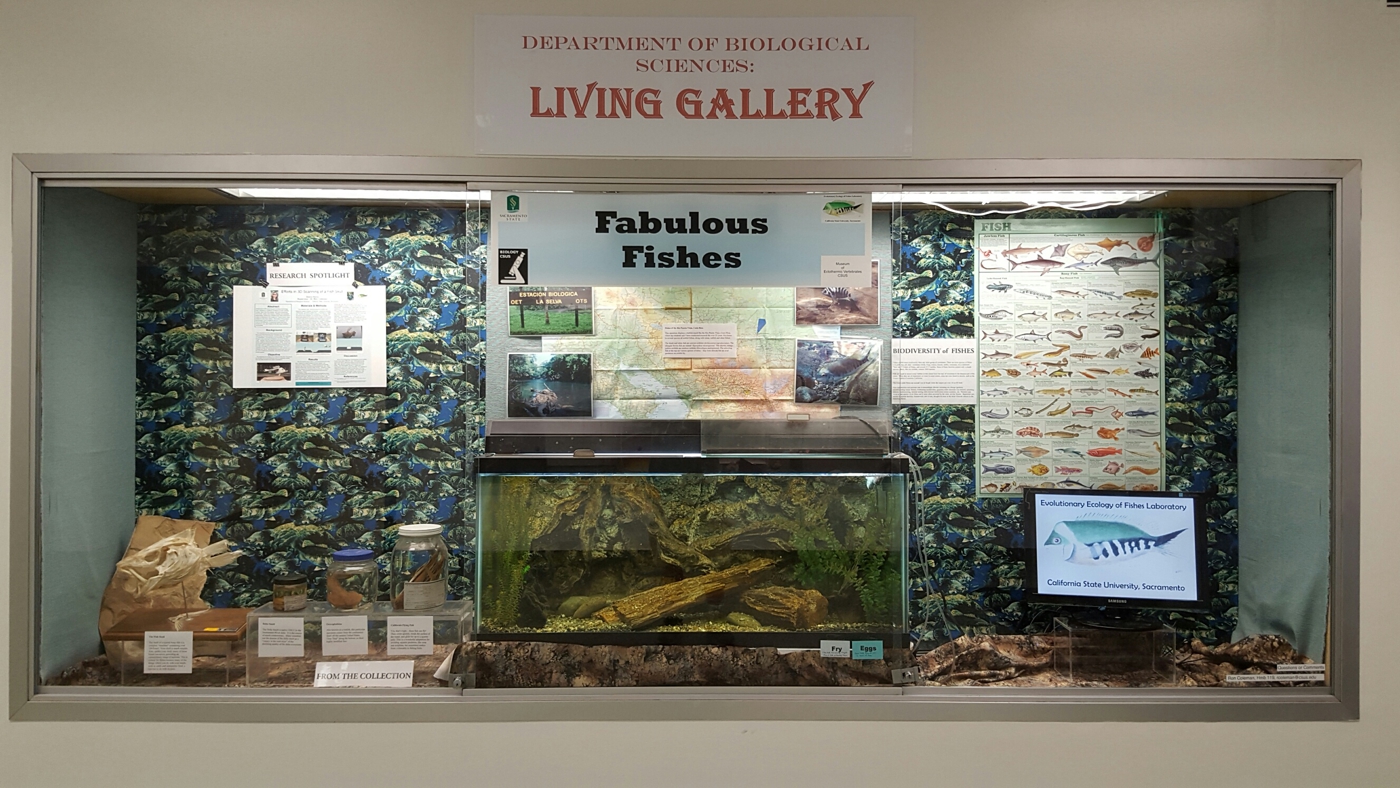CSUS Department of Biological Sciences Living Gallery
Curated by Merrill Roseberry, Roseberry@csus.edu
Current Exhibit -- Fabulous Fishes
"Fabulous Fishes" guest curated by Prof. Ron Coleman, rcoleman@csus.edu, 916-705-2606
Latest News
July 18: The parents are still going strong defending the kids.
July 16:The parents are doing a great job protecting the fry. There are still close to a hundred fry and they are getting bigger every day.
July 8: Fry! We have hundreds of fry. The convict pair at the left of the tank now is guarding a school of several hundred tiny fry. Today is their first day of swimming.
July 5: Surprise! If you look carefully, apparently at least one of the babies from the first batch survived -- I saw a small convict about 1/2" long in the tank today.
July 4: The eggs have hatched. The female has the wrigglers in a pit behind the central rock. They should be free-swimming in about four days.
July 1: One of the pairs of convicts has laid eggs! Of course, she laid them on the back side of the rock in the middle of the tank so you cannot see them from the front of the tank. You can see her dilligently guarding and fanning the eggs. They should hatch in about 3 days.
June 24: There are now two pairs of convict cichlids in the display aquarium. The tetras are growing rapidly.
June 9: Video clip about the display https://youtu.be/k1EO3sxIov4
June 7:The babies are gone! Yes, that happens. Parental care is tough in the fish world. The parents started with a couple of hundred eggs but over time, the numbers dwindled. Some of the eggs do not hatch properly; some of the wrigglers are weak. And, the predators are always watching, looking for a chance to snatch a straggler that wanders too far from the watchful parents. As the number of fry gets very small, the parents will sometimes eat the remaining few! Why? The theory is that it is too expensive to care for just a few fry, and because untended fry will quickly be eaten, the parents eat them themselves and recover the energy to use in making the next batch of kids. As I said, parental care is a tough business in the fish world. Most likely, they will spawn again within a couple of weeks so stay tuned.
June 5: The fry are growing and getting bolder everyday!
May 31: The fry are now free-swimming. Come see the parents take care of the kids.
May 28: Today the wrigglers are just starting to swim. The mother still has them in a pit in the center back of the tank, and the male is sometimes there as well. The kids will likely be free-swimming tomorrow or Tuesday.
May 24: The eggs have hatched! The female is guarding them in a pit in the center back of the tank. The male is patrolling the whole center of the tank to keep all the other fish away. This is a perfect example of biparental care, meaning both parents provide care to the offspring.
May 20: The convict cichlids laid eggs! On May 20, the female laid eggs on the backside of the piece of petrified wood on the right side of the tank. They should hatch in about 3-4 days, into wrigglers. Wrigglers cannot swim and the parents keep them in a pit. After about 5 more days, the babies can swim. At that point, we should see both parents guarding the school of fry.
Fabulous Fishes More Info
Fish Tank -- Fishes of the Rio Puerto Viejo, Costa Rica
This aquarium displays a habitat much like the Rio Puerto Viejo, Costa Rica, where my students and I have conducted research for over 25 years. It is home to several species of cichlid fishes, along with tetras, catfish and other fishes.
The black and white fish are convict cichlids (Archocentrus nigrofasciatus). The elongate brown fish are named Hypsophrys nicaraguense. The shorter, orangy-yellow cichlids are rainbow cichlids (Herotilapia multispinosa). The schooling fish at the top are various species of tetras – they look delicate but are avid predators on cichlid fry.
The Fish Skull
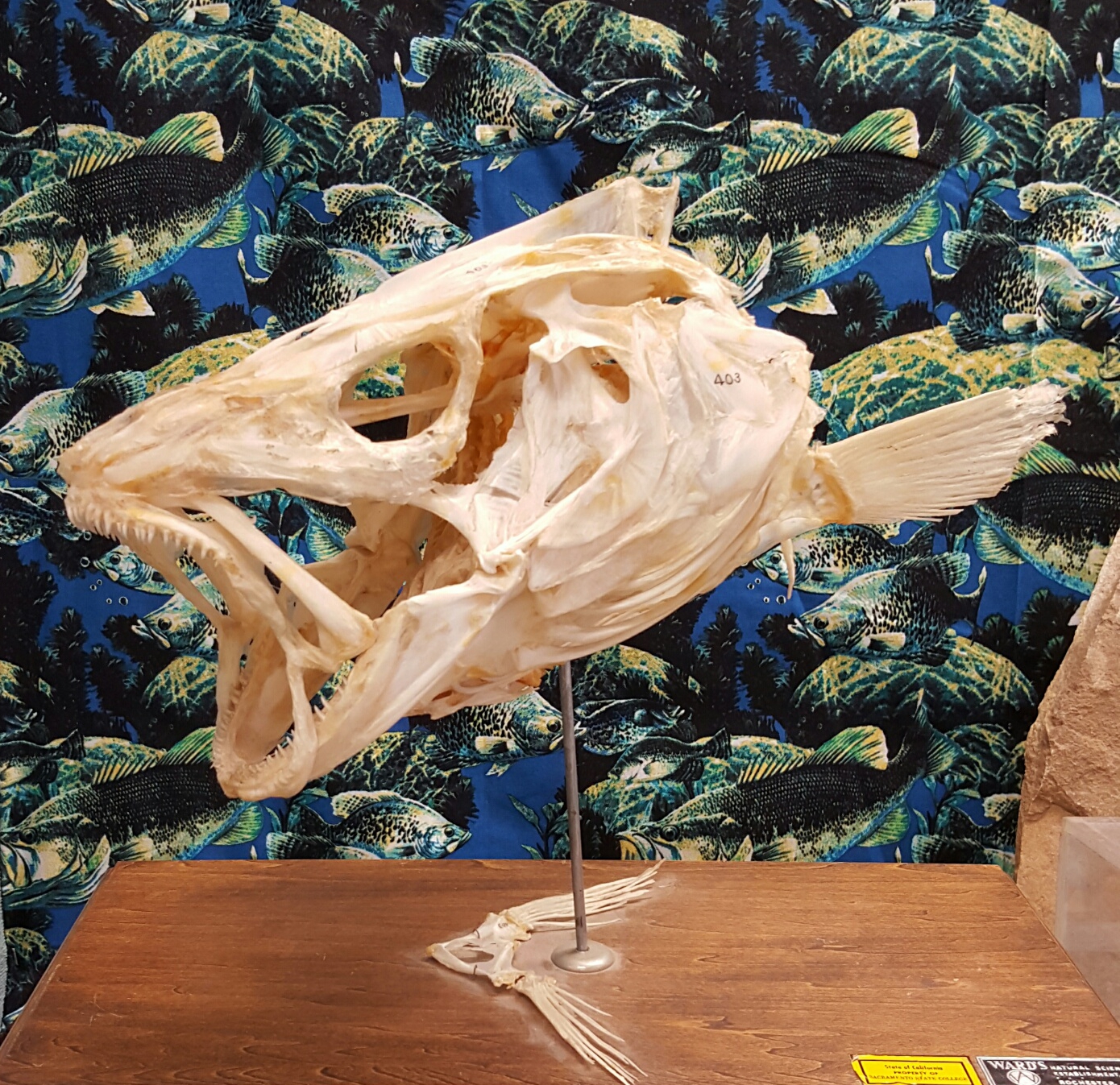
The skull of a typical bony fish is a complex “machine” containing over 100 bones. Your skull is much simpler. Also, unlike your skull, many of these bones can move, providing an extraordinary range of motions. This is critical for fishes because many of the things which you do with your hands, such as catch and manipulate food, a fish has to do with its jaws.
From the Collection Specimens
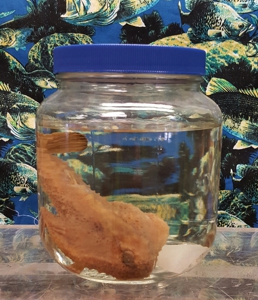
Ogcocephalidae: Also known as a batfish, this particular specimen comes from the continental shelf off the eastern United States. They “hop” along the bottom on their highly modified fins.
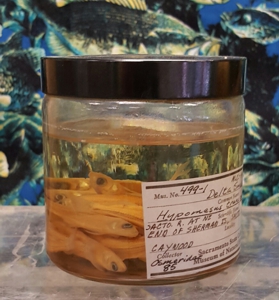
Delta Smelt: The Delta Smelt is native ONLY to the Sacramento River delta. It is the source of much controversey. Many scientists see the demise of the delta smelt as a “canary in the coal mine” of the declining quality of the delta ecosystem.
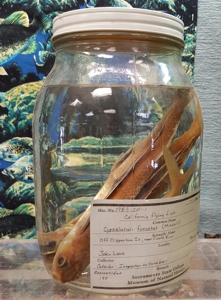
California Flying Fish: Yes, that’s right... these fish can fly! They swim quickly, break the surface of the water, and glide for up to a quarter mile. This is a wonderful adaptation for avoiding aquatic predators, like tuna and dolphins, but sometimes makes them vulnerable to fishing birds.
Research Spotlight
Current research on fishes
Assistance/Support/Donations
Thank you to Kristi Ryther for help designing the exhibit. Thank you to Anzo and Agnes Costa for donating the fish tank.
Coming Next
Silkworms
Past Exhibits
Quail
Butterflies
Ants
Stinky Flower
